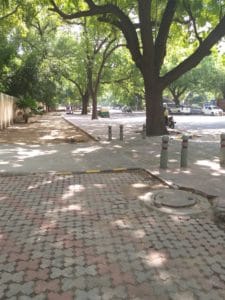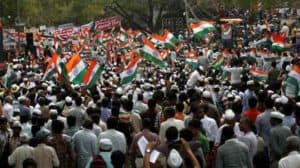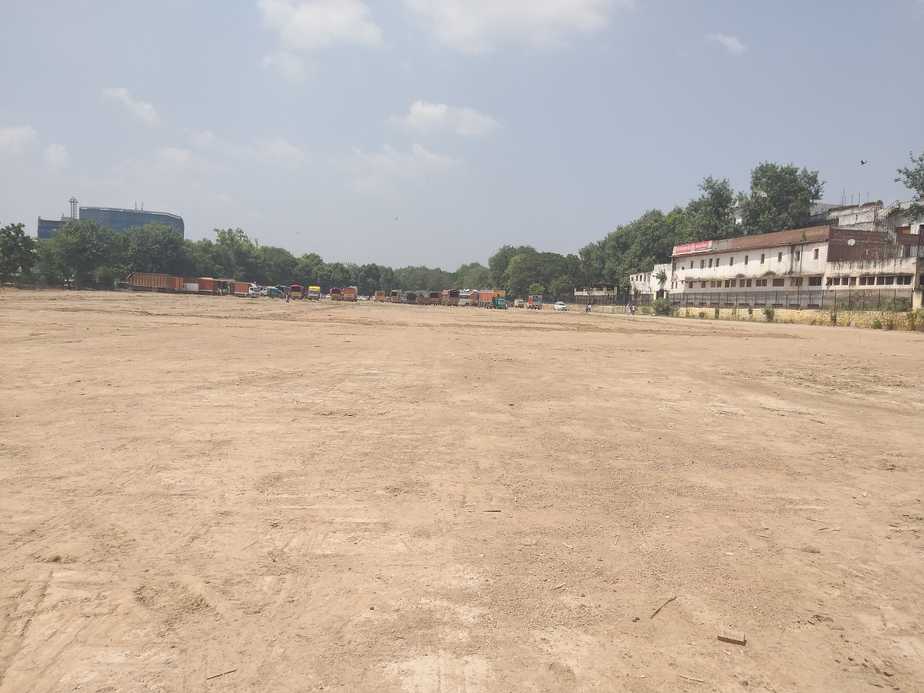After the SC lifted the ban on protests at Jantar Mantar with a few caveats, Protestors still find the new rules restrictive, and Ramlila Maidan, not a viable option
A barren land sans placards, sans loudspeakers, sans voices of dissent; no signs of a protest or a protestor – this is how the ground allocated for protests by the NGT, the Ramlila Maidan looks. Jantar Mantar Road, which had been synonymous with protests for 24 years, now appears quiet and deserted. Its proximity to Parliament House had made it a valuable location. Once a vibrant and symbolic battleground where Anna Hazare began his hunger strike, it currently looks desolate.
In July , SC passed a judgment lifting a blanket ban on protests at Jantar Mantar and the Boat Club and directed Delhi Police to devise guidelines for such agitations. “The right to protest is recognised as a fundamental right under the Constitution… crucial in a democracy…individuals and groups are able to express dissent and grievances, expose the flaws in governance and demand accountability,” the bench of Justices AK Sikri and Ashok Bhushan said in a 72-page judgment, emphasing that legitimate dissent is crucial for democracy.
But the court also agreed that the protests often become unruly, violating the right of residents to live peacefully. Therefore, the court said that a balance needs to be maintained between the rights of the protestors, under Article 19(1) (b) and those of the residents, under Article 21.

According to the guidelines proposed by Delhi Police last week, no more than 1,000 protestors will be allowed at Jantar Mantar Road. Prior permission will also be required for carrying out any such dharna and no more than two protests will be held in a day. Permission will be granted on first come first serve basis. Pitching of tents and staying there for months at a stretch will no longer be permitted. Only 2,000 people will be allowed on Parliament Street. At the Boat Club, only 100 people will be allowed and no demonstrations will be held.
At Jantar Mantar Road, protestors will not be allowed to burn effigies or documents, cook or litter. Loudspeakers can only be used with prior permission between 11 am and 4 pm. Police are concerned that huge gatherings had choked arterial roads and that protests like the one by Tamil Nadu farmers carry on for several months, creating “unhygienic surroundings” as they cooked, defecated and washed clothes in the open. Even when protests were allowed, Delhi Police were repeatedly promulgating Section 144 of the CrPC, considered and arbitrary act by many activists.
Last October, when the National Green Tribunal (NGT) banned protests at Jantar Mantar, it cited violations of environmental law. The residents had complained of major noise pollution foul smell. NGT found merit in their plea on three grounds – there is no executive order that demarcates Jantar Mantar as a protest site, Delhi Master Plan marks the area as a residential site and the agitations caused noise pollution.
In December, the ban was challenged in a PIL filed by Mazdoor Kisan Shakti Sangathan, through its founder member, Aruna Roy. Indian Ex-servicemen Movement and other organisations also appealed to the Supreme Court for help. They said that the ban effectively violates their fundamental right to protest.
Lawyer Prashant Bhushan, who argued in support of the MKSS, said in his appeal, “Holding peaceful demonstration by people in order to air grievances and to see that their voice is heard in the relevant quarters, is the right of the people.” He agreed that such rights are not absolute and can have certain restrictions but “the authorities are supposed to act within the limits of law and cannot indulge in excesses in what can be seen as another bid to stifle and impose unreasonable restrictions.”
This complaint was quite valid. While imposing the ban, NGT had proposed that if more than the permitted number of people are part of a protest, it should be held at the Ramila Maidan, otherwise it will be blacklisted. But Ramlila Maidan is away from the seat of power. To this, the SC said that in the age of Internet, platforms like WhatsApp and Twitter had the ability to carry their message to the authorities and the distance did not matter.
Ramlila Maidan in Old Delhi is rented out by the NDMC for Rs 50,000 for a day. Prabhloch Singh, the founder of Human Rights Protection Group and MFP Federation, has closely worked with many victims who have staged protests in Delhi. He says, “Protests will decrease now. It costs about Rs 50,000 to just book the Ramlila ground, which wasn’t the case with Jantar Mantar. The ground may keep women protesters away as it’s not that safe after it gets dark. In the scorching heat, there is very little shade. Also, multiple protests can’t be held at the same time, which wasn’t the case with Jantar Mantar.”

“I have witnessed protests and counter protests taking place at the Times Square in New York and in tourist hubs in Toronto, so why can’t protests take place at Jantar Mantar? We have never applied for permission for any of our protests and had only intimated the authorities once for a protest outside the PM’s residence in 2016. But all our protests have been peaceful and meaningful,” he says.
Singh adds, “Protestors should convey their grievances in a peaceful manner without causing inconvenience or any loss to public property. On the other hand, the government should also not alienate the protesters by imposing such restrictions and should engage in a meaningful dialogue. But if the protestors indulge in arson or attack school buses (Karni Sena’s protests), authorities should take strict action.”
According to many activists, NGT’s order weakened the resolve of protestors who used to come to Delhi from all over the country. There was a time when one could see tents on both sides of the Jantar Mantar Road, people sitting on charpoys and plastic sheets with placards and banners, there were many who had been protesting since months and years, holding onto the hope that their voices would be heard.
Since the protest site was shifted from the Boat Club to Jantar Mantar in 1993, it has been a symbol of protests in the capital. A man who used to protest at Jantar Mantar says on condition of anonymity, “We were there for different reasons, but a common aim – to seek justice. Protesting there made me feel that there are others like me. The area is close to those who hold power, which is why it was preferred by the agitators. It made us feel that our voices can be heard. It gave me hope, but when we were evicted from there, that tiny hope was also snatched away.”





